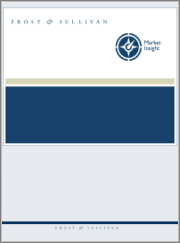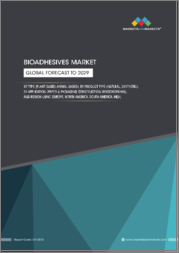
|
시장보고서
상품코드
1319194
세계의 바이오 접착제 시장 : 기술과 지적 재산(IP) 분석Bio-based Adhesives: Technology and IP Analysis |
||||||
바이오 접착제(Bio-based Adhesives) 강도, 내수성, 경제성 향상이 연구 개발을 촉진
접착제 업계는 휘발성 유기 화합물(VOC) 정부 규제 엄격화, 접착제 제조 독성 화학물질 금지, 지속 가능한 제품 소비자 수요 증가 등을 배경으로 계속 진화하고 있습니다. 이러한 변화 추세에 따라 접착제 제조업체는 지속 가능한 솔루션을 제공하고 환경, 사회 및 거버넌스(ESG) 목표를 달성하기 위해 지속 가능한 생산 및 소비 프로세스로 전환하고 있습니다.
Frost& Sullivan 연구는 지속 가능한 자원에서 유래하는 접착제 혁신을 확인하고 분석합니다. 본 보고서가 대상으로 하는 바이오 접착제는 식물 유래 접착제, 바이오 베이스 폴리머 접착제, 기타 바이오 접착제(바이오 유래 접착제, 미세 조류 유래 접착제 포함)입니다.
바이오 접착제는 합성 접착제보다 기계적 및 화학적 성능이 낮습니다. 연구 핵심은 바이오 접착제 특성과 성능을 향상시키기 위해 나노 스케일로 기능화된 나노 재료와 천연섬유를 통합할 전망입니다. 연구는 바이오 접착제와 관련된 문제를 해결하는 혁신적인 접근법을 찾는 이해 관계자에 의해 추진되고 있으며, 이로 인해 이러한 접착제 점유율이 증가하고 시장은 초기부터 세계의 상업 규모로 전환됩니다.
주요 논점
- 바이오 접착제 개발과 채용을 촉진하는 요인
- 바이오 접착제 유형 주요 요약
- 기술 파라미터 원재료, 연구 개발 노력, 장단점, 기술 준비 레벨에 초점을 맞춘 기술 분석
- 다양한 산업 바이오 접착제 채용에 관한 비교 평가를 포함한, 용도 전망
- 기술혁신 중점분야를 강조한 이해관계자 활동
- 지적재산 분석
- 성장 기회
목차
전략 과제
- 왜 성장이 어려워지고 있는가 The Strategic Imperative 8(TM) : 성장을 막는 요인
- The Strategic Imperative 8(TM)
- 바이오 접착제 업계 전략 과제 : 상위 3개 항목 영향
- 성장 기회 Growth Pipeline Engine(TM) 촉진
- 조사 방법
성장 기회 분석
- 분석 범위
- 조사 범위
- 엄격한 규제와 지속 가능한 솔루션 소비자 수요 증가가 기존 접착제 바이오 접착제로 전환 촉진
- 바이오 접착제 채용 성공을 위해서 임해야할 주요 과제
- 바이오 접착제 선택 기준
- 성장 촉진 요인
- 성장 억제 요인
- 지리적 전망 : 바이오 접착제 발전을 지원하는 동향
기술 주요 요약
- 식물 유래 접착제 : 접착제의 기계적 특성 개선
- 전분계 접착제 : 낮은 내수성 보급 방해
- 대두계 접착제 : 단백질계 접착제 중 가장 널리 연구
- 전분계 접착제의 높은 접착력
- 식물 유래 접착제 : 비교 분석
- 바이오 베이스 폴리머 접착제 개발자 : 접착제 기능성과 접착 강도 강화
- 천연 고무계 접착제 : 물이나 습기에 강하기에 습윤 환경에서도 효율적 사용
- 천연 고무계 접착제 : 바이오 베이스 폴리머 접착제 중 가장 높은 접착 강도 실현
- 바이오 베이스 폴리머 접착제 비교 분석
- 다양한 기재와 높은 적합성이, 바이오인스파이어드 접착제, 미세 조류 유래 접착제 개발 촉진
- 제조 복잡성이 바이오인스파이어드 접착제 발전 방해
- 미세조류 유래 접착제 : 높은 접착력, 입수 용이성, 저비용
- 미세 섬유화 셀룰로오스 : 바이오 접착제 보강재로서의 연구
- 나노 재료 : 바이오 접착제 물리역학적 특성 개선
활용 영역 전망
- 바이오 접착제 활용 영역 전망
- 업계 요구와 과제에 부응하는 바이오 접착제 능력
- 식물 유래 단백질 접착제 : 최종 사용자, 산업의 주목
- 폴리비닐알코올계 접착제 : 의료용도로 연구중
- 기타 바이오 접착제의 높은 적합성이 그 채용을 촉진할 가능성
지적 재산(IP) 상황
- 바이오 접착제 특허 출원 : 중국 우세
- 연구, 학술 기관 : 바이오 접착제 연구 개발 견인
- 상위 양수인 중점 분야 : 재료 유형별
- 식물 유래 접착제 특허 출원 활동의 상업화
- 폴리비닐알코올 : 바이오베이스 폴리머 접착제 중 가장 많이 연구되는 재료
- 강화재료 특허출원활동은 지난 5년간 안정
혁신 생태계
- 학술기관은 바이오 접착제의 새로운 발견에 주력
- 접착제 제조업체 최근 혁신 : 제품 제공 바이오베이스 함유량 증가 중시
- 시장 진출기업 : 업계 전체에 제품 보급 극대화에 주력
- 바이오 접착제 : 세계의 자금 조달과 투자 개황(2020-2023년)
- 파트너십과 협업이 신기술과 제품 개발에 주력
성장 기회 유니버스
- 성장 기회 1 : 바이오 접착제 기능 특성을 개선하기 위한 기능화 나노 재료 이용
- 성장 기회 2 : 바이오 접착제 개발을 위한 합성 경로 탐구
- 성장 기회 3 : 의료 용도 바이오 접착제 부가가치 연구
부록
- 기술 성숙도 레벨(TRL) : 설명
다음 단계
- 다음 단계
- 왜 Frost& Sullivan인가
- 면책사항
Efforts to Improve Bio-based Adhesives' Strength, Water Resistance, and Economic Viability Drive R&D Efforts.
The adhesives industry is evolving, attributed to the stricter implementation of government regulations for volatile organic compounds (VOCs), the ban on toxic chemicals in adhesive manufacturing, and the rising consumer demand for sustainable products. In line with these transformative trends, adhesive manufacturers aim to offer sustainable solutions while moving toward sustainable production and consumption processes to meet Environmental, Social, and Governance (ESG) goals.
This Frost & Sullivan study identifies and analyzes innovation in adhesives derived from sustainable sources. The bio-based adhesives the study covers are plant-based adhesives, bio-based polymer adhesives, and other bio-based adhesives (including bio-inspired adhesives and microalgae-derived adhesives).
Bio-based adhesives impart lower mechanical and chemical performance than synthetic adhesives. A lot of the research centers on the incorporation of functionalized nanomaterials and natural fibers, at the nanoscale, to improve bio-adhesives' characteristics and performance. Research is driven by stakeholders trying to find innovative approaches to address the challenges associated with bio-based adhesives, which will boost these adhesives' share and take the market from nascency to global commercial-scale deployment.
Key Discussion Points:
- Factors driving bio-based adhesives' development and adoption
- Overview of bio-based adhesive types
- Technology analysis, highlighting technical parameters, raw materials, R&D efforts, advantages and disadvantages, and technology readiness level
- Application outlook, including comparative assessment for the adoption of bio-based adhesives across various industries
- Stakeholder activities, emphasizing key focus areas of innovation
- Intellectual property analysis
- Growth opportunities
Table of Contents
Strategic Imperatives
- Why Is It Increasingly Difficult to Grow?The Strategic Imperative 8™: Factors Creating Pressure on Growth
- The Strategic Imperative 8™
- The Impact of the Top 3 Strategic Imperatives on the Bio-based Adhesives Industry
- Growth Opportunities Fuel the Growth Pipeline Engine™
- Research Methodology
Growth Opportunity Analysis
- Scope of Analysis
- Research Scope
- Strict Regulations and Rising Consumer Demand for Sustainable Solutions are Encouraging the Transition from Conventional to Bio-based Adhesives
- Key Challenges to be Addressed for the Successful Adoption of Bio-based Adhesives
- Selection Criteria for Bio-based Adhesives
- Growth Drivers
- Growth Restraints
- Geographic Outlook: Trends Supporting Bio-based Adhesives' Development
Technology Snapshot
- Plant-based Adhesive Developers are Improving Adhesives' Mechanical Characteristics
- Starch-based Adhesives' Poor Water Resistance can Hinder its Adoption
- Soy-based Adhesives are the Most Widely Researched among Protein-based Adhesives
- Starch-based Adhesives' High Adhesive Bond Strength Drives Interest in Them
- Plant-based Adhesives: Comparative Analysis
- Bio-based Polymer Adhesive Developers are Increasing Adhesives' Functionality and Bond Strength
- Good Resistance to Water and Moisture Allows Natural Rubber-based Adhesives to Operate Efficiently in Wet Environments
- Natural Rubber-based Adhesives Deliver the Highest Adhesive Bond Strength among Bio-based Polymer Adhesives
- Bio-based Polymer Adhesives: Comparative Analysis
- High Compatibility with Different Substrates Drives Bio-inspired and Microalgae-derived Adhesive Developments
- Manufacturing Complexities Hinder Bioinspired Adhesives' Development
- Microalgae-derived Adhesives are Gaining Interest among Researchers due to their High Adhesive Strength, Easy Availability, and Low Cost
- Microfibrillated Cellulose is Being Researched as a Reinforcing Material for Bio-based Adhesives
- Nanomaterials can Improve Bio-based Adhesives' Physiomechanical Properties
Application Outlook
- Bio-based Adhesives: Application Outlook
- Bio-based Adhesives' Ability to Address Industry Needs and Challenges
- Plant-based Protein Adhesives are Gaining Traction across End-user Industries
- Polyvinyl Alcohol Adhesives are Being Researched for Healthcare Applications
- High Compatibility of Other Bio-based Adhesives is Likely to Drive their Adoption
Intellectual Property Landscape
- China Dominates Bio-based Adhesive Patent Filling Activity
- Research Academia Drives Bio-based Adhesive R&D
- Key Focus Areas of Top Assignees by Material Type
- Plant-based Adhesive Patent Filing Activity is Being Translated to Commercialization
- Polyvinyl Alcohols are the Most Researched Materials among Bio-based Polymer Adhesives
- Patent Filing Activity for Reinforced Materials has been Steady over the Past 5 Years
Innovation Ecosystem
- Academia are Focusing on Finding New Approaches to Bio-based Adhesive Development
- Adhesive Manufacturers' Recent Innovation Emphasizes Increasing Bio-based Content in Product Offerings
- Market Participants are Focusing on Maximizing Product Penetration across Industries
- Bio-based Adhesives: Global Funding and Investment Snapshot, 2020-2023
- Partnerships and Collaborations Focus on New Technology and Product Development
Growth Opportunity Universe
- Growth Opportunity 1: Using Functionalized Nanomaterials to Improve Bio-based Adhesives' Functional Characteristics
- Growth Opportunity 2: Exploring Synthetic Routes to Develop Bio-based Adhesives
- Growth Opportunity 3: Researching Value-added Benefits for Bio-based Adhesives in Healthcare Applications
Appendix
- Technology Readiness Levels (TRL): Explanation
Next Steps
- Your Next Steps
- Why Frost, Why Now?
- Legal Disclaimer



















